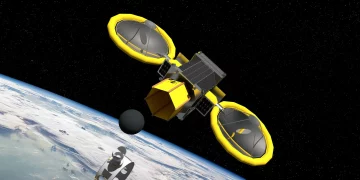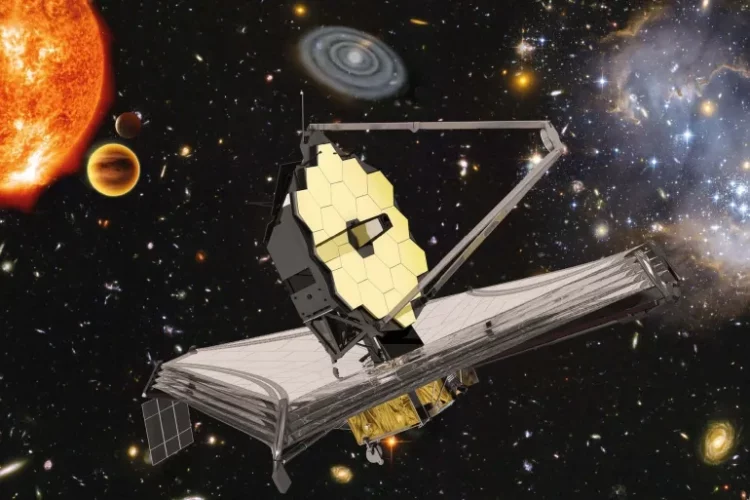Introduction: The Dream of Discovering Extraterrestrial Life
For centuries, humanity has gazed at the stars and wondered: Are we alone in the universe? The search for extraterrestrial life has been a central pursuit of astronomers, scientists, and thinkers throughout history. With the advancements in technology and the tools available to researchers, humanity is closer than ever to answering this age-old question. Among the most promising instruments on the front lines of this search is the James Webb Space Telescope (JWST)—a state-of-the-art observatory that is poised to provide the clearest insights into the universe’s deepest secrets.
Launched in December 2021, the JWST is a collaboration between NASA, the European Space Agency (ESA), and the Canadian Space Agency (CSA). As the most powerful space telescope ever built, it has already begun to deliver stunning images and data from the farthest reaches of the universe. But beyond capturing breathtaking images of distant galaxies and nebulae, JWST’s most exciting potential lies in its ability to analyze the atmospheres of exoplanets—planets orbiting stars outside of our solar system. This capability could bring humanity closer to discovering signs of life on distant worlds.
But are we on the brink of a groundbreaking discovery? Is the James Webb Space Telescope nearing the moment when it can definitively confirm the existence of extraterrestrial life? This article explores the ways in which the JWST is advancing the search for alien life, the potential discoveries it could make, and the broader implications of these findings for humanity’s understanding of life in the universe.
The James Webb Space Telescope: A New Era in Astronomical Observation
Before diving into the specifics of how JWST could help us discover extraterrestrial life, it is important to understand the advanced technology that makes it such a powerful tool. The James Webb Space Telescope is designed to complement and expand upon the work of its predecessor, the Hubble Space Telescope, with several key upgrades:
1. Infrared Vision
Unlike the Hubble Space Telescope, which primarily observes in visible and ultraviolet light, JWST is equipped with infrared instruments, allowing it to detect longer wavelengths of light. This ability enables JWST to peer deeper into space, observing objects and phenomena that would be obscured by cosmic dust or invisible in other wavelengths. Infrared vision is particularly useful for studying distant exoplanets, as it allows scientists to analyze their atmospheres in unprecedented detail.
2. High-Resolution Imaging
The JWST features a 6.5-meter primary mirror, significantly larger than Hubble’s 2.4-meter mirror, allowing it to capture more light and achieve much higher resolution images. This capability will enable scientists to study exoplanets, stars, galaxies, and other celestial objects in much finer detail than ever before.
3. Spectroscopy Capabilities
JWST is equipped with several instruments capable of performing detailed spectroscopic analysis. Spectroscopy allows scientists to break down light from distant objects into its component wavelengths, providing crucial information about their composition, temperature, and even the presence of atmospheric gases. For exoplanets, this means the ability to detect biosignatures—chemical markers that might suggest the presence of life.
These advancements make the James Webb Space Telescope a powerful tool in the search for extraterrestrial life, as it allows scientists to examine distant planets in greater detail than was previously possible.
The Search for Extraterrestrial Life: How JWST is Shaping the Future
The discovery of exoplanets—planets that orbit stars outside our solar system—has sparked a revolution in the search for extraterrestrial life. As of now, over 5,000 exoplanets have been confirmed, and many of these planets exist in the “habitable zone” of their stars, a region where conditions may be suitable for liquid water to exist. The presence of liquid water is considered one of the key ingredients for life as we know it, making these exoplanets prime targets for study.
But discovering a planet in the habitable zone is just the beginning. The next crucial step is to investigate whether these planets have the right conditions to support life—whether they have atmospheres that could sustain life, and if those atmospheres contain biosignatures like oxygen, methane, or carbon dioxide. This is where JWST’s capabilities come into play.
1. Studying Exoplanet Atmospheres
JWST’s primary focus in the search for extraterrestrial life will be its ability to analyze the atmospheres of exoplanets. By studying the light that passes through or reflects off an exoplanet’s atmosphere, JWST can identify the chemical composition of that atmosphere. Some key components scientists are looking for include:
- Oxygen (O₂): On Earth, oxygen is produced by photosynthetic organisms. Finding oxygen in an exoplanet’s atmosphere would be a strong indication of biological activity.
- Methane (CH₄): Methane is often produced by microbial life, though it can also be created by geological processes. If methane is found in combination with oxygen, it could point to biological activity, as these two gases tend to react with each other and are not typically stable in large quantities without a replenishing source.
- Carbon Dioxide (CO₂): CO₂ is another indicator of life, as plants and other organisms emit it during respiration. However, high concentrations of CO₂ could also suggest geological activity or the presence of volcanoes.
- Water Vapor (H₂O): Water is essential for life as we know it, and its presence in an exoplanet’s atmosphere could be a key clue in the search for life.
JWST is already set to make detailed observations of exoplanet atmospheres using its Near-Infrared Spectrograph (NIRSpec) and Mid-Infrared Instrument (MIRI). These tools will allow it to detect trace gases and other components that could indicate the presence of life.
2. Looking for Biosignatures
The concept of a biosignature refers to a substance or pattern in a planet’s atmosphere that could suggest the presence of life. Some of the most anticipated biosignatures include:
- Oxygen and methane: As mentioned, the combination of these two gases is particularly intriguing because, on Earth, they are both produced by living organisms, and they tend to react with one another, making their presence together unlikely without a continuous source of replenishment.
- Ozone (O₃): Ozone is a byproduct of oxygen and is essential for protecting life from harmful ultraviolet radiation. Finding significant amounts of ozone could be an important indicator of life-supporting conditions.
- Nitrous Oxide (N₂O): This compound is produced by biological processes, and its presence in the atmosphere of an exoplanet might suggest life.
JWST’s ability to study exoplanet atmospheres in detail could provide the first concrete evidence of biosignatures in distant worlds. If it successfully detects such signatures on a planet in the habitable zone, it could signal the first step toward confirming the existence of extraterrestrial life.

JWST’s Potential for Groundbreaking Discoveries
The James Webb Space Telescope is still in the early stages of its mission, but it has already provided some extraordinary results. In its first few months of operation, JWST has delivered stunning images of deep space and made significant strides in understanding the early universe. However, its true potential lies in its ability to study exoplanets and their potential to harbor life.
1. The First Signs of Alien Life?
While we are still far from making a definitive discovery of extraterrestrial life, JWST’s ability to analyze the atmospheres of exoplanets could potentially lead to groundbreaking results. If JWST detects biosignatures such as oxygen, methane, or other compounds indicative of life, it would be one of the most significant discoveries in the history of science. This would not only have profound implications for the search for life beyond Earth but would also challenge our understanding of biology, evolution, and the uniqueness of our planet.
2. Expanding the Search
JWST’s reach extends beyond our solar system and into the farthest corners of the galaxy, allowing scientists to study exoplanets in distant star systems that were previously unreachable by other telescopes. As JWST continues to scan the skies, the number of potential targets for study will only grow, increasing the chances of finding a planet with the right conditions for life.
Conclusion: The Future of Extraterrestrial Life Exploration
The James Webb Space Telescope represents a new frontier in the search for extraterrestrial life. With its unprecedented ability to study the atmospheres of exoplanets, it brings humanity closer than ever to answering the question of whether we are truly alone in the universe. While we are still awaiting definitive evidence of life beyond Earth, the potential for groundbreaking discoveries is greater than ever before.
As JWST continues its mission and reveals more about the distant worlds in our galaxy, it may be on the verge of making a discovery that will change the course of human history. Whether or not we find extraterrestrial life, the insights gained from JWST will undoubtedly reshape our understanding of the universe and our place within it. The search for life beyond Earth is no longer a question of if, but when—and with JWST leading the charge, that moment may be closer than we think.


















































Discussion about this post